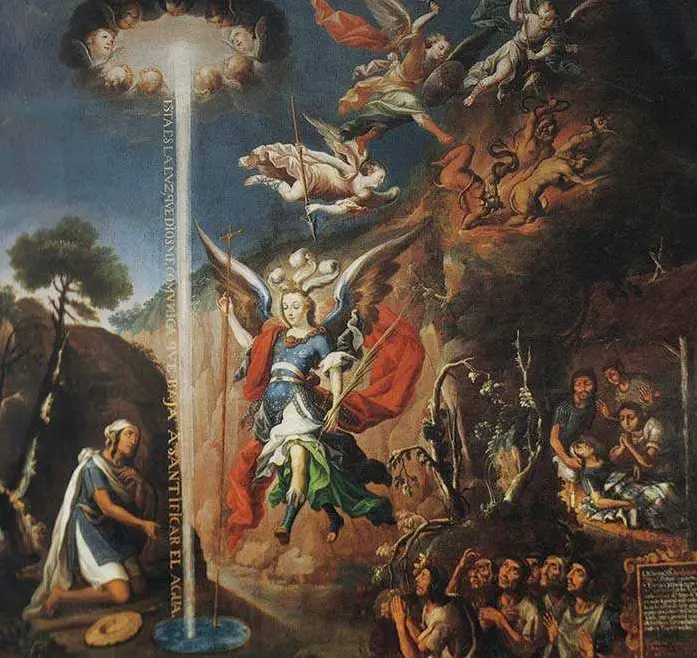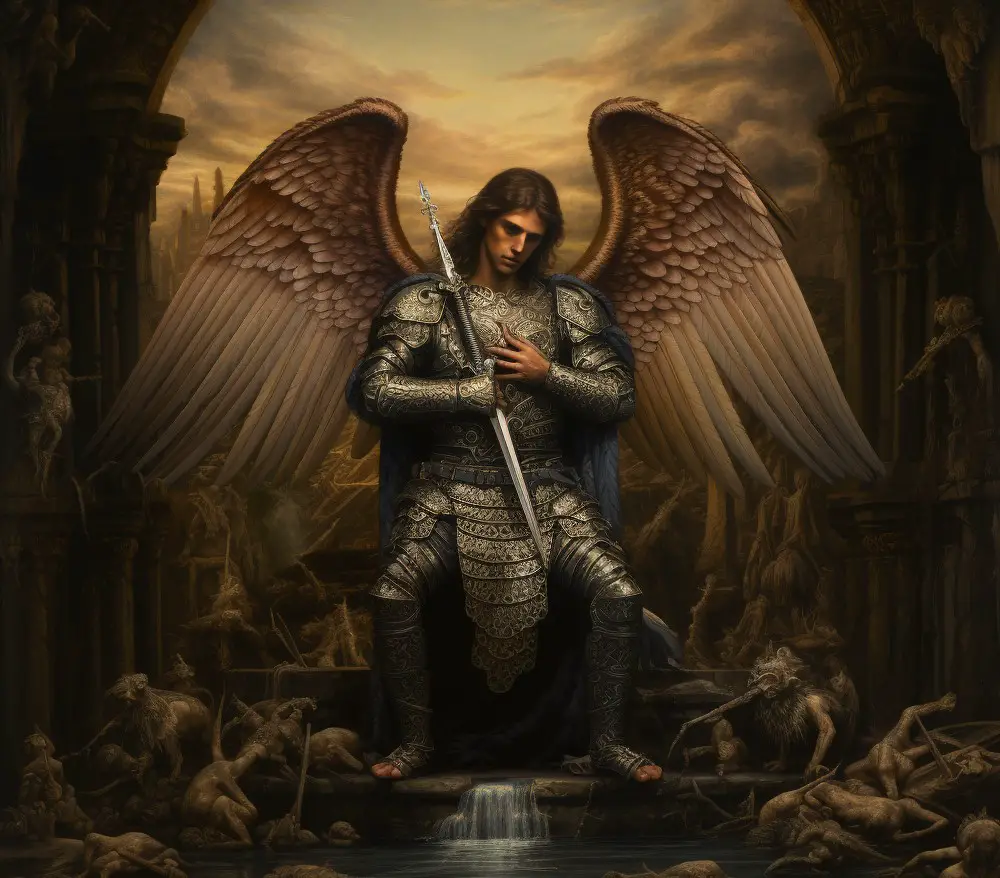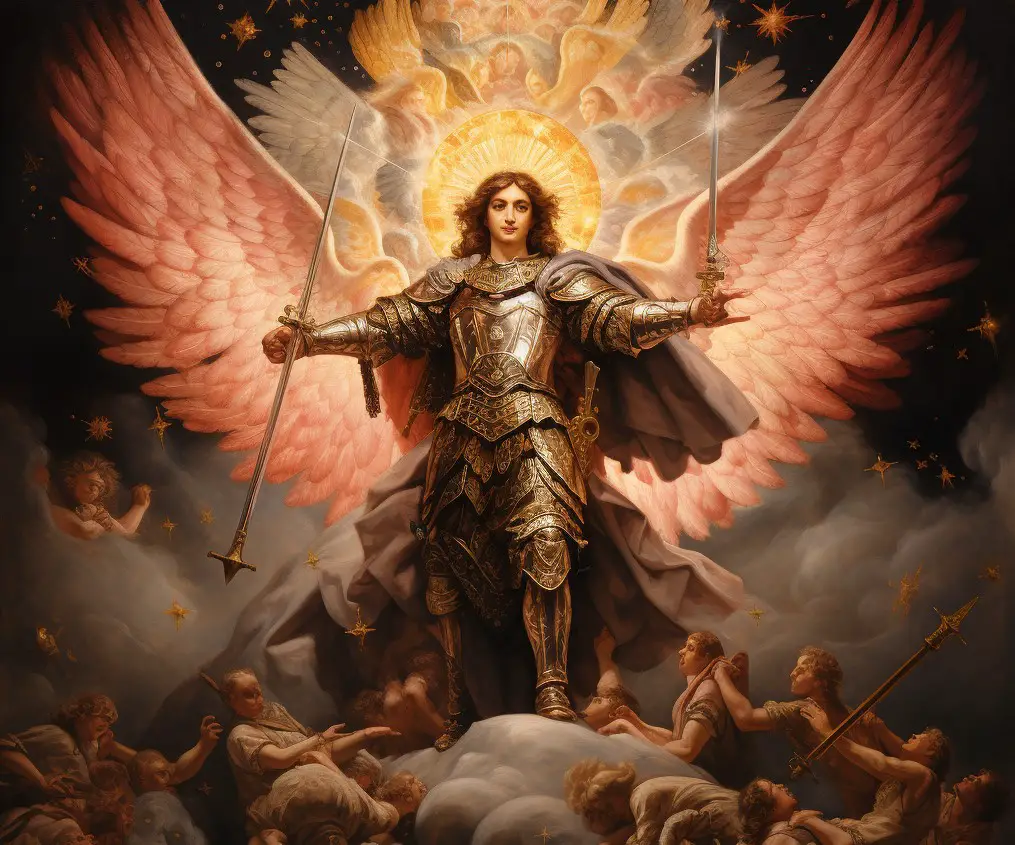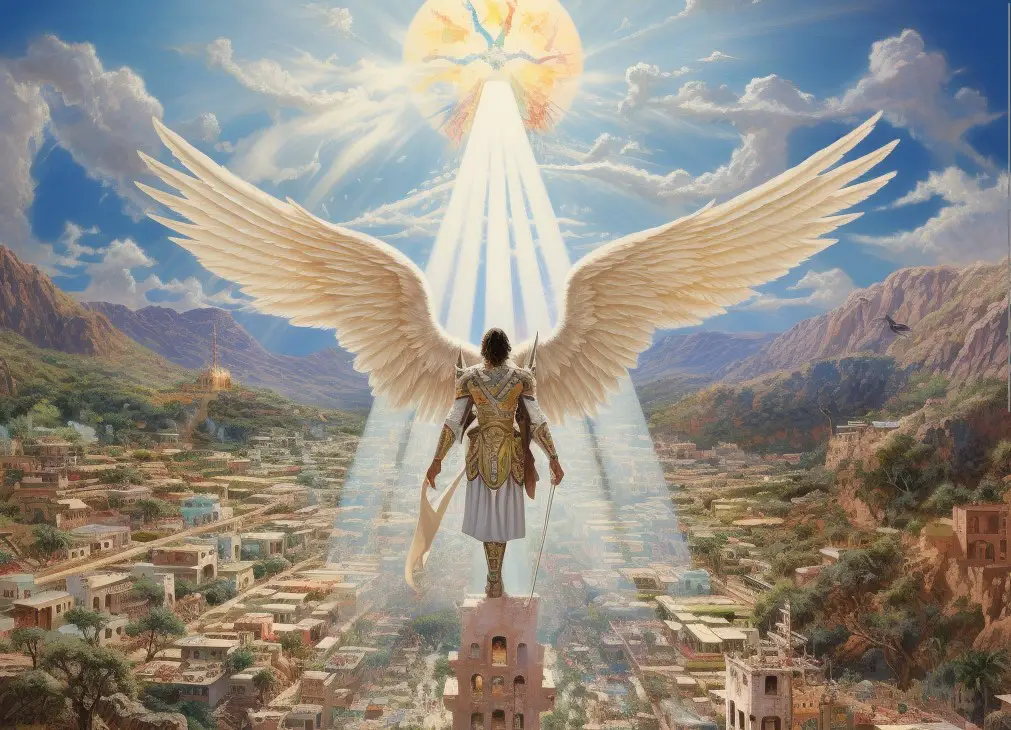Podcast: Play in new window | Download
Subscribe: Apple Podcasts | RSS
 The date was April 25, 1631, and the place was San Bernabé de Capula, Tlaxcala. The countryside was overrun with pestilence and to combat the plague the church fathers and civic leaders ordered a Procession of the Greater Litanies to beseech God’s mercy. That procession took place on El Día de San Marcos, or the feast day on the Catholic calendar devoted to Saint Mark. In that procession was a 17-year-old indigenous boy named Diego de San Lazaro. Diego walked with the group – the whole town was present – until time itself seemed to slow down and the boy found himself in what would be described today as an alternate reality. He was present and animate but yet everything around him had frozen into a haze. Then, the heavens opened and in front of him above his eye level bursts of light and color soon gave way to a familiar image of the Archangel Saint Michael, the Supreme Commander of Heavenly Hosts, wielding a sword and clad in protective armor. The angel spoke to the young Diego:
The date was April 25, 1631, and the place was San Bernabé de Capula, Tlaxcala. The countryside was overrun with pestilence and to combat the plague the church fathers and civic leaders ordered a Procession of the Greater Litanies to beseech God’s mercy. That procession took place on El Día de San Marcos, or the feast day on the Catholic calendar devoted to Saint Mark. In that procession was a 17-year-old indigenous boy named Diego de San Lazaro. Diego walked with the group – the whole town was present – until time itself seemed to slow down and the boy found himself in what would be described today as an alternate reality. He was present and animate but yet everything around him had frozen into a haze. Then, the heavens opened and in front of him above his eye level bursts of light and color soon gave way to a familiar image of the Archangel Saint Michael, the Supreme Commander of Heavenly Hosts, wielding a sword and clad in protective armor. The angel spoke to the young Diego:
“Know, my son, I am Saint Michael the Archangel and I have come to tell you that it is the Will of God and Mine that you tell the inhabitants of this town and its surroundings that in a valley between two mountain ridges you will find a miraculous source of water that will heal all diseases. It is under a large rock. Do not doubt what I tell you and do not neglect what I have sent you to do.”
In a swirl of light and color, like the closing of a portal to another dimension, Saint Michael disappeared, and the procession resumed its normal pace in normal time. Diego asked other people around him if they experienced what he had seen and they all said, “no.” After the ceremonies ended, the young man asked his neighbors and got the same response: no one saw the battle-ready archangel appearing so magnificently above the pious people. Diego dismissed the event as being something from his imagination. Perhaps the stress of the plague combined with the religious fervor of the ceremony had played tricks on his mind.
This was not the end of it, however. A few days later, the Supreme Commander of Heavenly Hosts reappeared to young Diego and this time he was not pleased. Saint Michael declared in a thundering voice:
“Why did you doubt what I have told you? Because you have not done as I commanded, you too, will now be stricken with the plague now afflicting your people.”
The archangel disappeared once again in a tempest of color and light, and within moments Diego started feeling ill. Within just a few days his condition worsened. After a few weeks, his family was certain that Diego was going to die as he had been wracked by fever and had wasted away to almost nothing. Priests were called in to administer last rites to the nearly dead boy. It was then that the archangel appeared again, in front of many witnesses. Saint Michael grabbed young Diego by the hand, made him stand up and then the two of them disappeared in the usual intense swirl of light and color.
 In a time immediately after these apparitions, the stories of these visitations were written down and were later compiled in a book authored by a Jesuit father named Francisco de Florencia and published in Puebla in 1898. From this book, we have a description of what happened after Diego returned home when he appeared out of nowhere into the same room where he had disappeared:
In a time immediately after these apparitions, the stories of these visitations were written down and were later compiled in a book authored by a Jesuit father named Francisco de Florencia and published in Puebla in 1898. From this book, we have a description of what happened after Diego returned home when he appeared out of nowhere into the same room where he had disappeared:
He announced to everyone, “Saint Michael transported me to the place he had told me about before. With Saint Michael going before me through the night, everything was illuminated as the great prince passed, as if it were midday. Rocks and branches split apart as he passed, clearing a path for us. As we reached a certain spot, I saw Saint Michael holding a golden staff topped with a cross. ‘From the place I touch with this staff will flow the miraculous spring I told you about during the procession. Make it clear to everyone that the illness you have suffered is a fruit of your disobedience.’
“Having said this, a great whirlwind rushed in amid the din of screams, wailing and moaning, as if a great crowd were being driven from the place. I shook with fear. It appeared the entire mountain ridge would tumble down on top of me during the turmoil.
“‘Do not fear,’ said my heavenly protector, ‘these are the sounds made by the demons, thine enemies, because they know the great benefits that through my intercession the faithful will receive in this place from Our Lord. Many, seeing the marvels worked here, will convert and do penance for their sins, and all will give thanks to God for His mercies. Those who approach with lively faith and sorrow for their faults will, with the water from this spring, obtain relief in their labors and needs, and find a comfort in these waters for the sick on the point of death.’
“This being said, I saw a brilliant light descend from heaven, piercing the ground at the site of the spring. Saint Michael then said, ‘This light that you have seen descend from heaven is the virtue God in His Divine Providence gives in this spring for the health and relief of the sick and needy. Make this known at once to everyone. That they may believe your testimony, I promise to work a great prodigy through you.’ With that, Saint Michael disappeared, and I found myself here once again, completely restored.”
 Diego’s family was amazed that the boy had returned completely healed of his sickness. They called in the head of the Franciscans to hear his story and then Diego was taken to the capital, Tlaxcala City, to have an audience with the governor. When Diego related his story to Tlaxcala’s governor, the esteemed government official did not believe it, and his stated reason for this was that the Archangel Michael would never have chosen a poor Indian boy to be his messenger. Diego and the priests returned to San Bernabé de Capula. Now home, the boy gathered family members to go and carry out the wishes of the angel. Diego led his group to the place of the spring, in the valley between mountain ridges. There was a large boulder there on top of where the spring should have been just as Saint Michael had stated, and it weighed about half a ton. Several strong men tried to move the gigantic rock but couldn’t. Diego said a small prayer to Saint Michael and tried moving the rock himself. He pushed the heavy boulder as if it were made of papier-mâché. Water then bubbled up from the earth where the rock once rested just as the archangel had predicted.
Diego’s family was amazed that the boy had returned completely healed of his sickness. They called in the head of the Franciscans to hear his story and then Diego was taken to the capital, Tlaxcala City, to have an audience with the governor. When Diego related his story to Tlaxcala’s governor, the esteemed government official did not believe it, and his stated reason for this was that the Archangel Michael would never have chosen a poor Indian boy to be his messenger. Diego and the priests returned to San Bernabé de Capula. Now home, the boy gathered family members to go and carry out the wishes of the angel. Diego led his group to the place of the spring, in the valley between mountain ridges. There was a large boulder there on top of where the spring should have been just as Saint Michael had stated, and it weighed about half a ton. Several strong men tried to move the gigantic rock but couldn’t. Diego said a small prayer to Saint Michael and tried moving the rock himself. He pushed the heavy boulder as if it were made of papier-mâché. Water then bubbled up from the earth where the rock once rested just as the archangel had predicted.
Word spread about the miraculous spring and people began going to the newly formed well to drink from the water, hoping for healings. The first to be healed was a little girl, and her family and neighbors saw it as a miracle. When Diego asked the girl’s parents to share their testimony with religious and government officials, they were reluctant to do so, thinking that they would somehow be reprimanded or would face the agents of the Holy Inquisition. A few days after the girl’s recovery, another person who drank from the well was also healed, and this person was reluctant to make the healing public for the same reasons stated by the parents of the cured little girl. Diego wanted to end the terrible plague and make the miraculous well known to all, but no one was cooperating. He turned again to the Prince of the Heavenly Armies, Saint Michael the Archangel.
When the angel heard Diego’s prayers, he once again appeared before the boy in his characteristic vortex of lights and colors. Saint Michael spoke and said this:
 “Why do you act cowardly, and are negligent in what two times now I have commanded you? Do you want to be punished once again for your disobedience? Arise, and have diligence in making known what I have commanded.”
“Why do you act cowardly, and are negligent in what two times now I have commanded you? Do you want to be punished once again for your disobedience? Arise, and have diligence in making known what I have commanded.”
Diego was at an impasse. Desperate, he filled a jug of water from the Well of Miracles and walked some twenty miles all the way to the city of Puebla to see the archbishop there. After saying a small prayer to Saint Michael, Diego was led through the offices of the archbishop and was granted an audience with His Excellency to relate the stories of the angel’s many appearances and the divine properties of the well. The archbishop gave the boy the benefit of the doubt and ordered the jug of water to be sent to the local hospital. There, people drank from the jug. One by one, all who sipped the water were miraculously healed of whatever ailment afflicted them. The archbishop then sent investigators to San Bernabé de Capula to test the water and to take down testimonies of healings and other miracles. In the ecclesiastical reports at the time, not only was it recorded that the plague was subsiding in the area, but the devotion to the Archangel Michael had increased dramatically. Some also claimed that there was a beautiful fragrance surrounding the well that would send people into a mild form of religious ecstasy. With the archbishop of Puebla satisfied as to the well’s divine properties, he ordered a small chapel built on the site which was christened San Miguel del Milagro, or Saint Michael of the Miracle. Since the 1630s, the numbers of pilgrims to this sacred spot have steadily increased and the chapel has been enlarged or rebuilt a handful of times to accommodate the many devotees coming in search of miracles. The shrine sees its biggest influx of visitors on two days of the year: April 25, which is the day of the first appearance of Saint Michael to the young Diego, and on September 29th which is the official feast day of the Archangel Saint Michael. People still drink the waters from the well in hopes of physical cures or to assist in life’s many battles. For the most part, Saint Michael does not disappoint the true believer.
REFERENCES
Broussard, Ben. “San Miguel del Milagro: The Apparition of Saint Michael in Mexico.” In, Crusade, January/February 2016, pp. 9-12.
Florencia, Francisco de. Narracion de la maravillosa aparicion que hizo el Arcángel San Miguel a Diego Lazaro de San Francisco. Puebla: Church documents, 1898.
